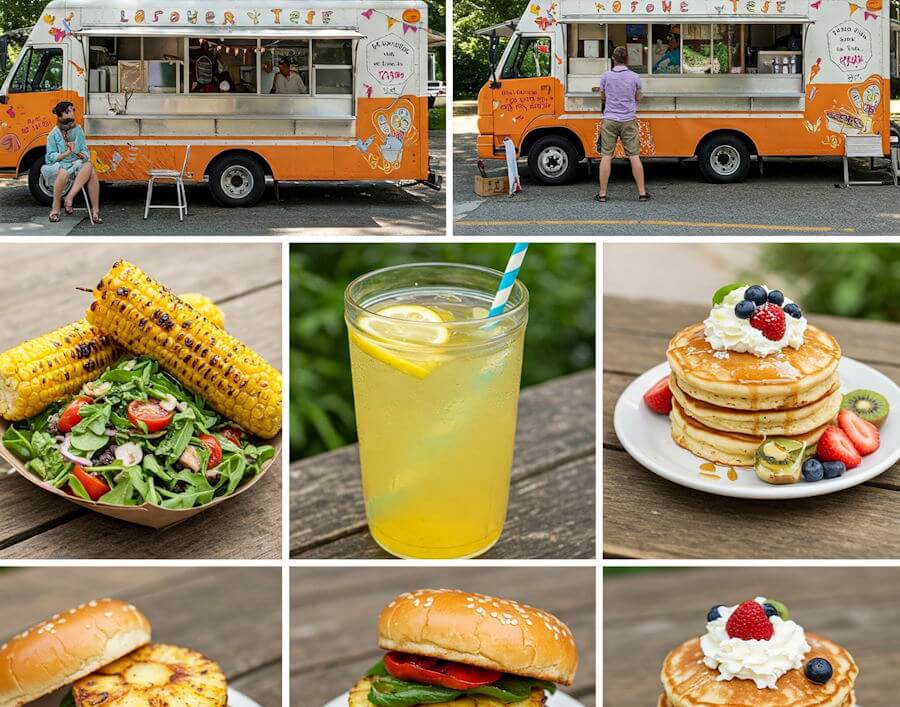Introduction to Seasonal Menus
In the dynamic landscape of the food truck industry, seasonal menus have emerged as a significant trend that caters to both culinary excellence and consumer preferences. Seasonal menus, which leverage ingredients that are at their peak freshness during specific times of the year, play a pivotal role in enhancing the overall dining experience. By incorporating locally sourced and in-season produce, food truck operators can not only elevate the taste of their offerings but also ensure that they align with sustainability practices.
The integration of seasonal ingredients promotes freshness, a critical aspect that modern consumers increasingly prioritize. When food truck vendors embrace this approach, they create dishes that not only feature vibrant flavors but also echo the essence of the season. For example, summer might inspire a refreshing watermelon salad, while fall could lead to a hearty butternut squash soup. By utilizing these ingredients in their menus, food trucks can entice clientele with creative dishes that are often unique and innovative.
Moreover, seasonal menus can significantly enhance customer experience. Diners are more likely to be intrigued by dishes that reflect the changing seasons, as they evoke a sense of familiarity and nostalgia. This connection to the seasons can foster loyalty towards the brand, as customers seek to enjoy these limited-time offerings. Additionally, by highlighting seasonal specialties, food trucks gain a competitive edge in a crowded market. Consumers appreciate the effort and thoughtfulness put into curating menus that evolve with agricultural cycles, which can differentiate one food truck from another.
In summary, seasonal menus are more than a trend; they represent a strategic approach that aligns freshness with consumer desires. By focusing on seasonal ingredients, food trucks can deliver superior taste, bolster customer engagement, and establish a distinctive market presence.
Benefits of Seasonal Ingredients
Utilizing seasonal ingredients in food truck menus provides numerous advantages that can significantly enhance both the culinary experience and operational efficiency. One of the primary benefits is the superior flavor that seasonal produce offers. Ingredients harvested at their peak ripeness not only taste better but also contribute to richer, more vibrant dishes, thereby increasing customer satisfaction and encouraging repeat business.
In addition to improved flavor, seasonal ingredients typically come at a lower cost compared to out-of-season produce, which often incurs higher prices due to transportation and storage expenses. Sourcing ingredients when they are abundant in the local market allows food truck operators to maintain a competitive pricing structure while maximizing profit margins. This cost-effectiveness can be particularly beneficial for smaller food truck businesses looking to establish themselves in a competitive environment.
Moreover, incorporating seasonal ingredients supports local farmers and fosters community relationships. By purchasing from local suppliers, food truck owners strengthen the local economy and contribute to the sustainability of agricultural practices. This collaborative approach not only benefits farmers but also enhances the food truck’s brand image by highlighting commitment to local sourcing and ethical practices.
The environmental impact of seasonal sourcing is another crucial aspect. Using ingredients that are in season reduces the carbon footprint associated with transporting food over long distances, aligning with eco-friendly practices that appeal to environmentally conscious consumers. Customers today are increasingly mindful of the origins of their food, and showcasing seasonal ingredients can enhance a food truck’s reputation as a sustainable choice.
Emphasizing the use of seasonal ingredients therefore not only elevates the culinary quality but positions food truck businesses as advocates for local agriculture and sustainability, appealing to a broader customer base.
Spring Menu Ideas
As spring blooms, food trucks can capitalize on the season’s fresh produce to create a vibrant and appealing menu. The arrival of spring brings a variety of fresh vegetables, herbs, and fruits that can invigorate any culinary offering. Items such as asparagus and peas can serve as the backbone of a light and refreshing menu, allowing food trucks to embrace the flavors of the season fully.
A creative approach to incorporating these ingredients could include a fresh asparagus and pea salad, drizzled with a zesty lemon vinaigrette, which highlights the natural flavors while keeping the dish light and nutritious. Additionally, several herbs, such as mint and basil, can be integrated to elevate the sensory experience. These vibrant salads not only appeal visually but also offer a healthy, refreshing option for customers seeking nutritious meals as they emerge from the winter months.
In terms of wraps, consider a light wrap using whole grain tortillas, filled with spring’s bounty. Ingredients such as grilled asparagus, fresh peas, and a choice of proteins, like chicken or tofu, can be added, along with a yogurt-based dressing infused with herbs. This option would not only showcase seasonal produce but also provide customers with a satisfying meal that is portable and easy to enjoy on the go.
Furthermore, spring festivals and outdoor events provide an excellent opportunity for food trucks to introduce refreshing beverages. Options such as herbal iced teas or smoothies made from spring fruits can capture the spirit of the season. By highlighting fresh ingredients and seasonal events in their menus, food trucks can effectively attract customers looking for innovative and delightful culinary experiences during the spring.
Summer Menu Ideas
Summer presents a fantastic opportunity for food truck operators to showcase vibrant and refreshing menu options that capitalize on seasonal ingredients. When considering summer menu ideas, it is essential to focus on dishes that not only appeal to the senses but also provide relief from the heat. Key ingredients such as ripe tomatoes, crispy cucumbers, and sweet berries can form the base of an enticing summer menu.
One popular option is grilled skewers, which can feature a variety of proteins and seasonal vegetables. Utilizing fresh tomatoes and bell peppers alongside marinated chicken or shrimp can create a visually appealing and flavorful dish. These skewers are not just delightful on the palate; they are also visually striking, which can help in attracting customers. Another option for summer is to offer a selection of cold soups, such as gazpacho, made from blended ripe tomatoes and cucumbers. This refreshing dish provides a quick and healthy way for patrons to enjoy the summer bounty while staying cool.
Additionally, incorporating smoothies into the summer menu can be an excellent strategy to tap into the health-conscious consumer market. Utilizing ingredients like mixed berries, refreshing mint, and yogurt can result in a deliciously hydrating beverage. Having a variety of flavorful smoothie options can entice customers looking for a quick nutrition boost.
While developing your summer menu ideas, it is important to consider the logistics of operating in warmer temperatures. Ensure that cold dishes and beverages are served promptly and maintained at the appropriate temperature to guarantee freshness and food safety. By offering vibrant, seasonal options, food truck owners can create an appealing summer menu that resonates with customers while effectively managing the operational challenges of the heat.
Autumn Menu Ideas
As the leaves change color and crisp air settles in, food trucks can capitalize on the bounty of autumn by showcasing seasonal produce such as pumpkins, apples, and root vegetables. These ingredients not only evoke the tastes associated with fall but also resonate with consumers who seek comfort food during cooler months. A thoughtfully crafted autumn menu can include a variety of hearty dishes and warming beverages that appeal to customers at seasonal events and celebrations.
One popular dish is the pumpkin soup, which can serve as a creamy, flavorful starter that highlights this iconic fall ingredient. By incorporating spices like nutmeg and cinnamon, food truck operators can elevate the dish and entice passersby with rich aromas. Additionally, offering a vegetarian or vegan version may expand customer reach, embracing the growing trend towards plant-based diets.
Another excellent option is to feature roasted root vegetables. Dishes such as a roasted root vegetable medley or a warm salad with beets, carrots, and sweet potatoes can provide hearty, nutritious offerings that align with the season. Consider adding a drizzle of balsamic reduction for a touch of gourmet flair, appealing to those looking for elevated comfort food.
When it comes to sweet treats, caramel apples or apple crisps can create a nostalgic connection for many customers. Introducing unique variations, such as spiced apple cider donuts, can also attract attention and draw customers to the food truck. Pairing these dishes with warming drinks like chai tea, hot apple cider, or pumpkin spice lattes not only complements the menu but enhances customer experiences as well.
Marketing these autumn menu ideas during fall events, farmers’ markets, or holiday festivals can create an engaging atmosphere. Highlighting the use of local produce in promotional materials emphasizes sustainability while appealing to consumers’ desire for fresh, homegrown flavors. Presenting a seasonal menu rich in autumnal offerings ensures food trucks remain a favored choice among patrons seeking out comforting fall cuisine.
Winter Menu Ideas
As the colder months approach, food trucks can thrive by offering warming and hearty dishes that resonate with the winter season. Utilizing winter ingredients such as cabbage, sweet potatoes, and citrus fruits can not only enhance the menu but also attract customers seeking comfort food in a cozy setting. These ingredients provide excellent nutritional value and versatility, making them ideal for various creative preparations.
One popular dish that captures the essence of winter is a cabbage and sausage stew. This dish, enriched with spices and slow-cooked to amalgamate flavors, offers a hearty, satisfying meal perfect for chilly days. Additionally, incorporating sweet potatoes in a baked or mashed form can create delightful sides or entrees. A sweet potato and black bean taco can serve as a vegetarian option that is both filling and flavorful. Topping it with a zesty citrus salsa made from fresh oranges or grapefruits could elevate the dish, providing a refreshing contrast to the warm elements.
To complement these dishes, consider introducing innovative drink options that enhance the winter dining experience. Hot apple cider, infused with spices or served with a splash of rum, can be a delightful offering. Alternatively, a spiced hot chocolate made with dark chocolate and topped with whipped cream may appeal to a wide audience, especially families with children. Crafting a warm drink menu encourages customers to linger, fostering a welcoming atmosphere that is crucial for food truck success during the colder months.
Creating a cozy environment around the food truck is essential as well. Incorporating elements such as outdoor heaters, warm lights, and seating arrangements that invite customers to relax can significantly enhance their overall experience. This strategy not only increases customer satisfaction but can lead to increased sales and repeat visits throughout the winter season.
Incorporating Holiday Themes
Food trucks provide a unique opportunity to embrace seasonal menus that resonate with the festive spirit throughout the year. By integrating holiday themes into offerings, food truck operators can create a sense of community engagement and draw in customers eager to celebrate special occasions. For instance, during Halloween, food trucks can offer creatively named items such as “Wicked Witch’s Brew” soups or “Ghostly Grilled Cheese” sandwiches, utilizing festively decorated presentations to enhance visual appeal.
As Thanksgiving approaches, operators can pivot to heartwarming dishes that align with the holiday’s themes of gratitude and family. Seasonal favorites such as turkey sliders, cranberry sauce, and savory stuffing can be showcased within a limited-time menu. This approach not only provides comfort food to the patrons but also captures the essence of the holiday, creating memorable experiences for customers.
Christmas presents a wonderful opportunity to further innovate menu items with festive flavors such as peppermint-infused desserts or eggnog milkshakes. Themed food items, such as “Santa’s Sweet Treats” or “Rudolph’s Red Velvet Waffles,” can capitalize on holiday excitement, prompting customers to seek out these limited-time offerings. Decorating the food truck with holiday lights and ornaments can create an inviting atmosphere that draws in foot traffic and enhances the overall experience.
Additionally, New Year’s celebrations can be embraced with lighter fare and bubbly drinks as people often seek healthier options after indulgent holiday meals. Incorporating celebratory themes into food offerings maintains customer interest throughout the year, ensuring they return for seasonal specialties.
By thoughtfully incorporating holiday themes, food trucks can carve a niche in the competitive food market, providing festive flavors that resonate with their audience and create lasting memories.
Adapting to Regional Seasons
Understanding the unique geographical and climatic conditions that define various regions is crucial for food truck owners. Each locality has its own seasonal calendar that dictates the availability of produce. For instance, while summer fruits like peaches and berries might thrive in temperate zones, tropical areas may offer an array of mangos and coconuts year-round. Recognizing these variations allows food truck operators to make informed decisions about their menu offerings, catering to the local palate.
Seasonal menus play a significant role in connecting food trucks with their communities. By utilizing locally sourced ingredients, food truck owners not only enhance the freshness of their meals but also support local farmers and producers. For example, promoting dishes that feature local vegetables and grains not only aligns the menu with the season but also resonates with consumers who value sustainability and community engagement.
Moreover, adapting the menu to highlight seasonal specialties can create a unique identity for the food truck. Foodies often seek out culinary experiences that reflect the essence of a region. By integrating local flavors and seasonal ingredients, food trucks can attract and retain customers who appreciate thoughtful dining experiences. Consider incorporating touchpoints in your branding that celebrate local traditions or seasonal events; this fosters a deeper connection with patrons, and encourages them to return.
In conclusion, understanding and adapting to regional seasons is essential for food truck success. Emphasizing locally available seasonal produce not only enhances menu quality but also strengthens community ties. This approach not only improves customer satisfaction but can also lead to sustained business growth through the faithful patronage of local customers.
Customer Engagement and Feedback
Customer engagement is critical for food trucks, particularly when introducing seasonal menu items. By effectively involving customers in the menu development process, food truck owners can not only enhance their offerings but also foster a stronger relationship with their clientele. One effective approach is to incorporate seasonal specials into the marketing strategies. By highlighting these unique menu items through targeted promotions, food trucks can generate excitement and anticipation, prompting customers to visit more frequently.
Moreover, actively encouraging customer input can greatly improve menu offerings. This may include directly asking regular patrons for their opinions on new seasonal items or conducting surveys through various platforms—online or in-person. Establishing an interactive environment invites customers to share their ideas, tastes, and preferences regarding seasonal flavors. This feedback not only aids in refining the current menu but also helps in planning future seasonal offerings that align more closely with customer expectations.
Social media platforms play a pivotal role in showcasing seasonal offerings. Food trucks can utilize these sites to post visually appealing photos of their seasonal menu items, create polls to garner customer opinions, and promote upcoming seasonal features. Engaging visuals, accompanied by compelling descriptions, can entice potential customers while simultaneously reinforcing the established community feeling among returning clientele. In addition, utilizing features such as live videos or stories can provide an authentic behind-the-scenes look at the preparation of seasonal specials, inviting customers into the culinary experience.
Overall, leveraging customer engagement and soliciting feedback are essential techniques for food trucks. These practices not only enhance customer loyalty but also contribute to the successful adaptation of seasonal menu items, helping food trucks to continually meet and exceed customer expectations.




